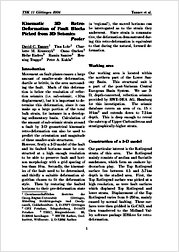| dc.contributor.author | Tanner, David C. | |
| dc.contributor.author | Lohr, Tina | |
| dc.contributor.author | Krawczyk, Charlotte M. | |
| dc.contributor.author | Oncken, Onno | |
| dc.contributor.author | Endres, Heike | |
| dc.contributor.author | Samiee, Ramin | |
| dc.contributor.author | Trappe, Henning | |
| dc.contributor.author | Kukla, Peter A. | |
| dc.contributor.editor | Philipp, Sonja | |
| dc.contributor.editor | Leiss, Bernd | |
| dc.contributor.editor | Vollbrecht, Axel | |
| dc.contributor.editor | Tanner, David | |
| dc.contributor.editor | Gudmundsson, Agust | |
| dc.date.accessioned | 2010-11-26T13:21:21Z | |
| dc.date.accessioned | 2013-01-28T10:19:29Z | |
| dc.date.available | 2010-11-26T13:21:21Z | |
| dc.date.available | 2013-01-28T10:19:29Z | |
| dc.date.issued | 2006-03 | |
| dc.identifier.citation | Philipp, S.; Leiss, B; Vollbrecht, A.; Tanner, D.; Gudmundsson, A. (eds.): 11. Symposium "Tektonik, Struktur- und Kristallingeologie"; 2006, Univ.-Verl. Göttingen, p. 226 - 228. | |
| dc.identifier.isbn | 3-938616-40-7 | |
| dc.identifier.uri | http://hdl.handle.net/11858/00-1735-0000-0001-3447-A | |
| dc.description.abstract | Movement on fault planes causes a large
amount of smaller-scale deformation,
ductile or brittle, in the area surrounding
the fault. Much of this deformation
is below the resolution of reflection
seismics (i.e. sub-seismic, <10m
displacement), but it is important to determine
this deformation, since it can
make up a large portion of the total bulk strain, for instance in a developing
sedimentary basin. Calculation of
the amount of sub-seismic strain around
a fault by 3-D geometrical kinematic
retro-deformation can also be used to
predict the orientation and magnitude
of these smaller-scale structures.
However, firstly a 3-D model of the fault
and its faulted horizons must be constructed
at a high enough resolution
to be able to preserve fault and horizon
morphology with a grid spacing of
less than 10 m. Secondly, the kinematics
of the fault need to be determined,
and thirdly a suitable deformation algorithm
chosen to fit the deformation
style. Then by restoring the faulted
horizons to their pre-deformation state
(a ‘regional’), the moved horizons can
be interrogated as to the strain they
underwent. Since strain is commutative,
the deformation demonstrated during
this retro-deformation is equivalent
to that during the natural, forward deformation... | |
| dc.format.mimetype | application/pdf | |
| dc.language.iso | deu | |
| dc.publisher | Universitätsverlag Göttingen | |
| dc.relation.ispartof | 11. Symposium "Tektonik, Struktur- und Kristallingeologie" | |
| dc.subject.ddc | 551 | |
| dc.subject.gok | TQC 220 | |
| dc.subject.gok | TSB 000 | |
| dc.subject.gok | VAE 200 | |
| dc.subject.gok | VAE 400 | |
| dc.subject.gok | VBE 000 | |
| dc.title | Kinematic 3D Retro-Deformation of Fault Blocks Picked from 3D Seismics | |
| dc.type | anthologyArticle | |
| dc.subject.gokverbal | Reflexionsseismik {Geophysik} | |
| dc.subject.gokverbal | Mitteleuropa {Geophysik} | |
| dc.subject.gokverbal | Geodynamik der Lithosphäre {Geologie} | |
| dc.subject.gokverbal | Tektogenese {Geologie} | |
| dc.subject.gokverbal | Modellierung von Prozessen in der Geosphäre | |
| dc.bibliographicCitation.firstPage | 226 | |
| dc.bibliographicCitation.lastPage | 228 | |
| dc.identifier.doi | 10.23689/fidgeo-1823 | |
| dc.type.version | publishedVersion | |
| dc.subject.free | Niedersächsiches Becken | |
| dc.subject.free | Dreidimensionale Seismik | |
| dc.subject.free | Störung <Geologie> | |
| dc.subject.free | Kinematik | |
| dc.subject.free | Modell | |
| dc.relation.collection | Geologische Wissenschaften | |
| dc.description.type | conference | |


